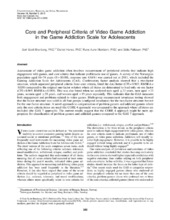Core and peripheral criteria of video game addiction in the game addiction scale for adolescents
Peer reviewed, Journal article
Published version

Åpne
Permanent lenke
https://hdl.handle.net/1956/11700Utgivelsesdato
2015-05Metadata
Vis full innførselSamlinger
Originalversjon
https://doi.org/10.1089/cyber.2014.0509Sammendrag
Assessment of video game addiction often involves measurement of peripheral criteria that indicate high engagement with games, and core criteria that indicate problematic use of games. A survey of the Norwegian population aged 16–74 years (N=10,081, response rate 43.6%) was carried out in 2013, which included the Gaming Addiction Scale for Adolescents (GAS). Confirmatory factor analysis showed that a two-factor structure, which separated peripheral criteria from core criteria, fitted the data better (CFI=0.963; RMSEA=0.058) compared to the original one-factor solution where all items are determined to load only on one factor (CFI=0.905, RMSEA=0.089). This was also found when we analyzed men aged ≤33 years, men aged >33 years, women aged ≤33 years, and women aged >33 years separately. This indicates that the GAS measures both engagement and problems related to video games. Multi-group measurement invariance testing showed that the factor structure was valid in all four groups (configural invariance) for the two-factor structure but not for the one-factor structure. A novel approach to categorization of problem gamers and addicted gamers where only the core criteria items are used (the CORE 4 approach) was compared to the approach where all items are included (the GAS 7 approach). The current results suggest that the CORE 4 approach might be more appropriate for classification of problem gamers and addicted gamers compared to the GAS 7 approach.
